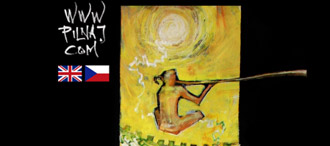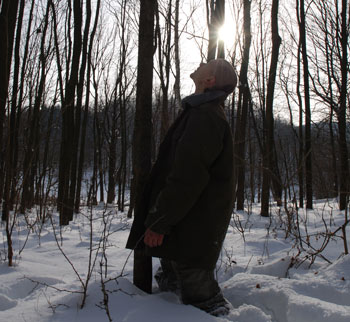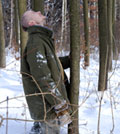
|
||
 |
 |
|
 |
 |
 |
 |
 |
 |
 |
 |
 |
 |
 |
 |
 |
 |
 |
 |
 |
 |
 |
 |
|
 |
 |
| My path I personally perceive all the branches and trunks I treat as a certain kind of beings coming out of the forest. Just like we did once. They have their fates and stories they want to share. It is an honour for me to allow them to become musical instruments – the most sublime form wood can turn into. |
|
 |
 Search
Search
The process of making a didgeridoo starts with searching, observing and meeting. It is a wonderful, creative game. To walk through the forest and to imagine the branches to be beautiful instruments, to guess their sound. The greatest joy is to recognize an instrument in deadwood – a fallen dry tree. If I decide to cut down a living tree, I at least try to benefit the forest by doing so. It means I choose those branches and trunks that are either half-fallen, broken or growing densely in groves. Thus I let more light into the forest and the other trees get space to become strong.
Where
To get good sound qualities, it is desirable to find wood as dense as possible. Therefore, it is good to search in places not ideal for the certain kind of wood. That is – shadowy north-oriented hillsides, dense groves and bosks, dry places and alpine areas where trees grow slowlier.
Moon wood
KYou can improve the qualities of wood by cutting down a tree according to natural processes and rhythms, i. e. by using the lunar calendar based on cycles of the lunar phase. During the descending lunar phase – from a full moon to a new moon – the energy of nature proceeds downwards and inwards. Applied to a tree, it means its water and nutrients are stored in the roots. Consequently, we get much drier wood, unattractive to wood-eating insects. Generally, it is better to fell a tree during the days closer to a new moon. For those interested in wood treatment according to the wisdom of the old traditions, I recommend an excellent book by Erwin Thoma – Dich Sah Ich Wachsen (I Saw You Growing).
Experience
I have fell trees during the new moons in winter for the last three years and the outcome is evident. For instance, big acacia trunks 30 cm in diameter cracked only insignificantly in the cross section after two years of drying. It is very surprising because this kind of wood usually cracks all along its length.
Most convincing, however, is an event that happened to me last winter. I fell a big ash tree and cut a wedge (a cross section of a tree) out of it. I liked its drawing so I took it back home. After I changed, I forgot it on a bench right next to a stove. I noticed it again only after three days. I took it into my hands. And could not believe my eyes. It stayed solid, straight and without a single crack. Moreover, it stayed like this after being cut out in the forest in – 10°C (14°F) and transported to a room to 30°C (86°F) next to the stove, where it remained for three days. What quality will be such wood after two years of slow drying in the shade?!
Handcraft I do prefer to use hand tool as much as I can during whole manufacturing. From tree felling to cutting and surface treatment. Firstly, I enjoy working in tranquil and silent evironment and secondly, in using the hand tools I found my way to self-sufficiency and to a world with less or no factories, trucks and wires of all kinds.
I do touch the wood rather with sharp-edge instruments then with sandpapers. Specially on last surface treatment in regards to keep its microlayer rather cuted then grained. Its resistance and appearance then will last for decades. As proved on old axe-cuted beams compared to today´s mashine cuted wood qualities.
Creating the hollow
Originally, a didgeridoo is hollowed out by termites. I haven’t found them in the Czech republic yet, so I have to cut the trunks in half along their length or bore them with a hand drill – an auger. Traditional genuine instrument to drill wood along the fiber´s direction, prooved by centuries of use. As temporary black-smiths are not able to forge it anymore, one has to search for them in farm house atics, bazars etc.
Surface
Wood talks to us also through its surface which itself is a microworld. Just close your eyes and touch the unpolished surface of an ash or a roughly processed larch. Smell it. Wood talks to us in its own intimate way. Wood breathes through its enourmous inner surface, its many pores, capillaries and microscopic tubes and reacts to every change of air humidity. Therefore, I use only natural oils and waxes for the surface treatment (cestadreva.cz).
If we coat the surface with varnish – what do we touch then? Who can we then communicate with?